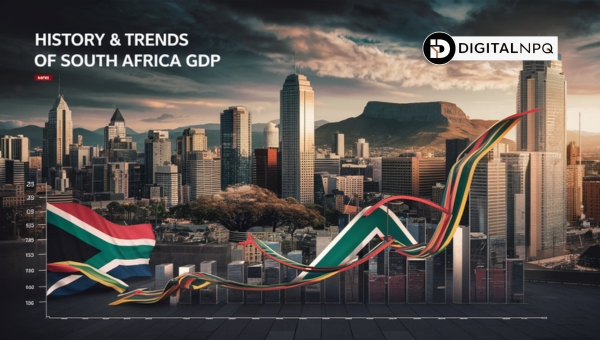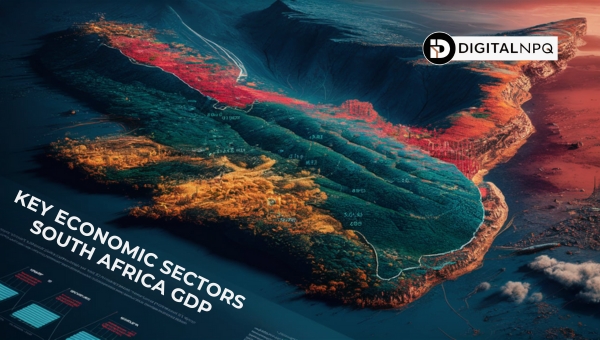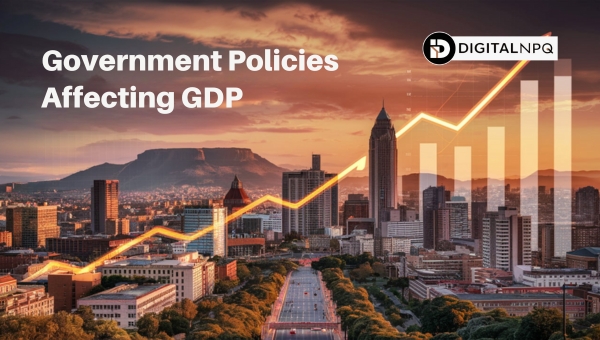South Africa GDP: Key Trends, Sectors, & Future Projections

If you’re eager to understand the dynamics of South Africa GDP, you’ve come to the right place. This article delves into historical trends, key economic sectors, and important government policies.
We’ll also compare South Africa’s growth with other emerging markets and provide future projections. Dive in to gain insights that can help you navigate the complexities of South Africa’s economy with ease.
History & Trends of South Africa GDP
Over time, South Africa’s GDP has exhibited a range of tendencies that mirror the nation’s fluctuations in the economy.

Beginning in the early 1960s, the GDP increased gradually while facing both substantial obstacles and rapid growth. This voyage provides understanding of the state of the economy and the different forces driving expansion and contraction.
GDP Data from 1960 to 2023
Let’s dive into the specific GDP data from 1960 to 2023:
- 1960: The GDP was $8.75 billion, marking the lowest recorded value.
- 1970s-1980s: This period saw moderate growth, with the GDP reaching approximately $56 billion by 1980.
- 1990s: The post-apartheid era led to increased economic activities, with GDP rising to around $136 billion by 1999.
- 2000s: The early 2000s witnessed robust growth, peaking at $458.20 billion in 2011, the highest recorded value.
- 2010s: The GDP experienced volatility due to various economic challenges, including global financial crises and domestic issues.
- 2023: The current estimate stands at $377.78 billion.
These figures highlight both the peaks and troughs, showcasing the dynamic nature of South Africa’s economy.
Previous Releases, Highs, and Lows
Reviewing significant points in South Africa’s GDP history reveals important moments:
- 1960: $8.75 billion, the lowest recorded GDP.
- 1994: The end of apartheid marked a turning point, leading to increased economic activities.
- 2011: The GDP peaked at $458.20 billion, the highest recorded value.
- 2020: The global pandemic caused a notable decline, reflecting the economic impact of COVID-19.
These releases underscore critical moments in South Africa’s economic journey, illustrating periods of significant growth and notable declines.
Key Economic Sectors
South Africa’s economy is diverse and encompasses various key sectors that significantly contribute to its GDP. Let’s delve into three major sectors: agriculture and food processing, business process outsourcing, and trade and investment.

Agriculture and Food Processing
Agriculture plays a vital role in South Africa’s economy, providing both employment and food security. The sector’s contribution to GDP is noteworthy, particularly due to:
- Crop Production: Maize, wheat, and sugarcane are among the primary crops.
- Livestock Farming: Includes cattle, poultry, and sheep farming.
- Food Processing: Adds value to raw agricultural products, creating various food items for local consumption and export.
Business Process Outsourcing
The business process outsourcing (BPO) sector has become a significant contributor to GDP growth in South Africa. This sector is characterized by:
- Job Creation: Offering employment opportunities to a large segment of the population.
- Foreign Investment: Attracting investments from international companies.
- Service Exports: Providing services such as customer support and IT services to global clients.
Trade and Investment
Trade and investment are crucial for South Africa’s economic health. The country has a diverse export base and attracts foreign direct investment (FDI) in several sectors:
- Exports: Minerals, precious metals, and agricultural products are key exports.
- FDI: Investments in mining, manufacturing, and services sectors.
- Trade Agreements: Participation in various trade agreements to boost commerce.
Also Read: Walmart Capital One Payment: Everything You Need to Know
Government Policies Affecting GDP
Government policies play a crucial role in shaping South Africa’s economic landscape. From land reforms to black economic empowerment and the debate over nationalizing mines, these policies significantly impact the nation’s GDP. Understanding these policies helps in assessing their effectiveness and anticipating future economic trends.

Land Reform and Property Rights
Land reform policies in South Africa aim to rectify historical inequalities by redistributing land to marginalized communities.
These policies are designed to promote economic inclusivity and boost agricultural productivity. However, the implementation of land reforms has been met with several challenges:
- Uncertainty and Investment: The lack of clarity around land ownership can deter investment in agriculture and other land-based industries.
- Operational Efficiency: Newly redistributed land often faces issues related to operational efficiency, which can reduce overall productivity.
- Economic Participation: On the positive side, land reform can increase economic participation among previously disadvantaged groups, potentially leading to a more inclusive economy.
It’s essential to balance the need for historical justice with economic efficiency to ensure that land reforms positively impact GDP.
Black Economic Empowerment
Black Economic Empowerment (BEE) initiatives are designed to address economic disparities by promoting the participation of black South Africans in the economy. These initiatives have various facets:
- Ownership: Encouraging black ownership of businesses.
- Management: Increasing black representation in management positions.
- Skills Development: Focusing on education and training to build a skilled workforce.
- Employment Equity: Ensuring fair employment practices to create a more inclusive job market.
BEE initiatives contribute to GDP by fostering a more inclusive economy, though they can also pose challenges for businesses adapting to new regulations. The overall impact is a more equitable economic environment that aims to uplift historically marginalized communities.
Nationalization of Mines Debate
The nationalization of mines is a topic that has sparked considerable debate in South Africa. Proponents argue that nationalizing mines could lead to more equitable distribution of wealth and increased state revenue.
However, there are multiple aspects to consider:
- Investment Climate: Nationalization could deter foreign investment, affecting the mining sector’s growth.
- Operational Efficiency: State-run enterprises often face challenges related to efficiency and productivity.
- Revenue Distribution: While nationalization might increase state revenue, the effectiveness of wealth distribution remains a question.
The debate highlights the need to balance economic growth with social equity. Nationalization has the potential to transform the mining industry, but it must be approached carefully to avoid disrupting one of the country’s key economic sectors.
Also Read: Anchor Program New Jersey: Your Guide to Property Tax Relief
Comparison with Emerging Markets
Comparing South Africa’s economic growth with other emerging markets offers a unique perspective on its position in the global economy.
South Africa, often considered a gateway to Africa, has shown moderate economic growth compared to other emerging markets like China, India, and Brazil.
- China: Over the past few decades, China has experienced rapid economic growth, transforming into a global economic powerhouse. Its GDP growth rate has consistently outpaced South Africa, driven by industrialization and export-oriented policies.
- India: India has also seen significant growth, particularly in the IT and services sectors. Its demographic dividend and economic reforms have contributed to a higher growth rate compared to South Africa.
- Brazil: Brazil, another BRICS nation, shares some similarities with South Africa, such as reliance on natural resources. However, Brazil’s diversified economy and larger domestic market have often resulted in slightly higher growth rates.
Despite these comparisons, South Africa has its unique strengths. Its well-developed infrastructure, financial services sector, and strategic location make it an attractive destination for investment in Africa.
However, challenges such as political instability, policy uncertainty, and structural issues have hindered its growth relative to other emerging markets.
It’s essential to note that while South Africa’s growth may appear modest, its potential for future development remains significant, particularly if structural reforms and policy adjustments are effectively implemented.
Future Projections
Looking ahead, South Africa’s GDP is poised for several shifts that could reshape its economic landscape. While short-term forecasts suggest a period of stabilization, long-term projections indicate a gradual upward trend. Let’s delve into the specifics of these future projections.
Short-Term Forecast
In the short term, South Africa’s GDP is expected to experience moderate growth. By the end of 2024, estimates suggest that the GDP will reach approximately $382.31 billion.
This forecast considers various factors, including:
- Economic recovery post-pandemic
- Government stimulus packages
- Increased consumer spending
- Improved business confidence
- Stabilization of key economic sectors
Long-Term Projections
Looking further ahead, long-term projections for South Africa’s GDP indicate a steady but gradual increase. By 2025, the GDP is anticipated to reach around $387.28 billion. This upward trend is expected to continue, with projections for 2026 estimating a GDP of approximately $393.48 billion. Key drivers for this growth include:
- Continued foreign investment
- Expansion in key sectors such as mining and manufacturing
- Technological advancements
- Policy reforms aimed at economic inclusivity
- Infrastructure development initiatives
These projections highlight a cautiously optimistic outlook for South Africa’s economic future, emphasizing the importance of sustained growth and strategic planning.
FAQs
Is South Africa’s economy good?
South Africa’s economy has seen both growth and challenges. It has a diverse industrial base but also faces issues like unemployment and inequality.
Is South Africa a nice place to live?
South Africa offers a rich cultural heritage and beautiful landscapes. However, it is important to consider factors like safety and economic conditions when evaluating living standards.
What is the largest industry in South Africa?
The mining sector is the largest industry in South Africa. It plays a significant role in the country’s GDP and employment.
Conclusion
South Africa’s GDP has traversed a complex journey from the 1960s to the present day. Despite facing numerous economic challenges, the country’s key sectors such as agriculture, business process outsourcing, and trade remain pivotal to its growth.
Government policies like land reform and black economic empowerment have also played significant roles in shaping the economic landscape. Comparing South Africa with other emerging markets provides valuable insights into its unique position and future potential. Understanding these dynamics is crucial for anyone interested in economic trends and development.
If you found this analysis helpful, explore more insightful articles on our site to deepen your understanding of global economies!
